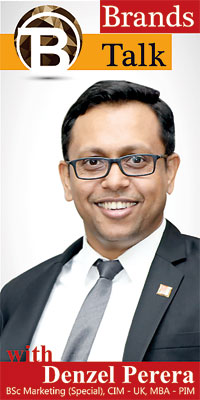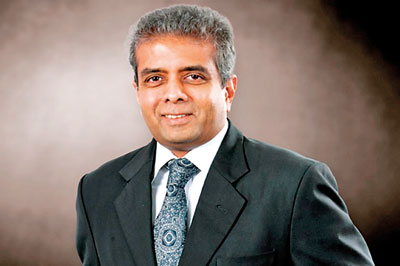Swimming Upstream with INCLUSION – The story of Dialog
View(s): Addressing the second biennial memorial oration of Late Professor Liyanage, the Group Chief Executive Officer – Dialog Axiata Group – Dr Hans Wijayasuriya, unfolded the story of Dialog from its inception, which was set up with an ambitious target of becoming the market leader within three years of its establishment in 1997 in the Sri Lankan market.
Addressing the second biennial memorial oration of Late Professor Liyanage, the Group Chief Executive Officer – Dialog Axiata Group – Dr Hans Wijayasuriya, unfolded the story of Dialog from its inception, which was set up with an ambitious target of becoming the market leader within three years of its establishment in 1997 in the Sri Lankan market.
He made sure to thank his team, that was with him at the beginning, who probably would have been instrumental in cracking strategies that conquered the market in a short span of 3 years. The aspiration of the team was to be the market leader in the year 2000.
The captain of the team was an engineer by profession who thought of swimming upstream in achieving the shared dream of the team. What was most remarkable was that Dr Wijayasuriya spoke of his journey of reaching the pinnacle without mentioning the brand name – “Dialog” even once in his speech, in an era where CEOs harping of their brand at every possible juncture when given the opportunity to speak in public.
As the last entry to the market by 1997, Dialog was number four in the list of mobile telecommunication service providers in the country.
Needless to mention that Celltel (Later became Tigo and then Etisalat) was the first to enter the market. First mover advantage Cell-tell occupied in the market was not powerful enough for them to fight against the tides of Dialog.
What made it possible for Dialog to win the market so fast? And what were the strategies Dialog adopted in creating the winning formula? are the key insights which will be shared based on Dr Wijayasuriya’s oration delivered at the Postgraduate Institute of Management on the invitation of the Memorial Oration Guidance Committee.
Theory of Exclusion vs Theory of Inclusion
and strategy
It was about making telecommunication services only available to those who can afford it and to those who have the power of buying. The same is also known as “Market Skimming” where only the affordable pie of the market can enjoy the benefits of products and services. Hence, consuming these services was also a prestige.
Market Skimming is the opposite of Market Penetration in which the total market is reached in one go as opposed to the strategy of taking the market layer by layer. Which could also be referred to as a shift from prestige to masstige (Mass-prestige) in which case a premium product comes at an affordable price.
History of Inclusion
Michel Foucault who studied (1960s) the modern history of exclusion Vs inclusion, makes it central to his approach in understanding the development of modern institutions of emerging liberal societies. Second, it traces the political ecology (and etiology) of ‘social inclusion’ as a response to the crisis of the welfare state and the French Republican tradition of social solidarity initiated in France by Rene Lenoir and subsequently adopted as a fundamental principle for the European social model.
Third, it provides a philosophical discussion of inclusive education that draws the distinction between the legal and moral legitimation of rights and questions the moral justifications (or the lack of them) offered for the right to inclusive education.
Going by the same philosophy the Dialog team led by Dr Hans was able to practically apply this in the Sri Lankan context when mobile communication was exclusive to the top and maybe the middle end of the pyramid.
Inception of Inclusion in the mind of the strategist
From 1997 to 2000 – climbing from no 04 to no 1 within 3 years or just 36 months, Dialog must have done something right. It says that a strategist must be audacious – so that he is mentally ready to accept foreseeable challenges and incise his team to absorb external shocks without being shaken internally.
A strategist to practice inclusiveness in policies must emanate not from the greed of making extra ordinary profits but to empower a nation with opportunities which are limited to an exclusive niche.
Taking an example from the FMCG market, Dr Hans elaborates how the thought of inclusion incubated in his mind considering the offers of sachet packs; which probably reminds you of the bottom end of the pyramid but Dr Hans’s elaboration was that even one from the top end of the pyramid would come to a point where they make use of sachets; be it in a luxury hotel where the tea or coffee is self-made (DIY) or packing your bags for an overseas trip where one would need to carry instant relief medicines (Link Samahan) or coffee (Nescafe) etc. it’s just a simple idea; enabling consumers to use the brand or the product based on their requirement.
This made Dialog offer Re-loads and various other product offers to ease out the pain-points of customers in all three strata of the social pyramid.
 Analysing Inclusion from a marketing lens
Analysing Inclusion from a marketing lens
1. Analysing under the meta theory of branding and strategy; According to Prof Michael Porter, a brand should be taking a stand; either Cost-Leadership or Differentiation. Being stuck in the middle is not appreciated. However, that was in the 1980s when Porter introduced the strategy. Today, a new hybrid is considered, which goes under the label of Best Cost Strategy which is recommended where consumers look for a differentiated offer at a reasonable price.
2. Inclusion is also about market penetration than market skimming as explained above.
3. In brand marketing, the fundamental strategy that a firm can take is STP where the market is segregated into strata where one stratum is targeted. However, under the strategy of inclusion, the brand has been able to cut through many strata, to be able to remain relevant. Instead of going by the demographic factors, under the approach of inclusion, Dialog has gone with the behavioral factors which is also a segmenting criterion use in today’s context more than the age-old demographic and psychographic criteria.
4. Another important element of Branding is the ability of a brand to offer an experience. Dialog has offered a unique experience to its customers and through the strategy of inclusion; this experience was made available to the masses by making it affordable. Dr Wijayasuriya ascribes this to Aspiration Needs of the Population where Aspiration could mean Elevation or elevating one’s self from current consumption point to a higher position by experiencing something better and latter (Population) is referred to the overall market. The enabler of the strategy in the case of Dialog is technology which enables Dialog to meet the requirements of the market.
1. Availability – Immediacy and Reach
2. Affordability – Total cost of service and minimum cost of serving/ access
3. Applicability – Context based offerings which have high relevance
4. Affinity – Aspiration, Personalization, Experiential alignment, and Trust

Source: Dr. Wijayasuriya (Model of Inclusion)
There were many interesting points which Dr Wijayasuriya highlighted in his speech of which Inclusion was the key highlight. “Nirvana of Sustainability” that was elaborated in the latter part of his speech will be discussed in next week’s article.


